All you need to know about
Tomorrow Solar eclipse
________________________________________________
26 Dec 2019, 10:01
Max View in Kathmandu Valley
Global Event: Annular Solar Eclipse
Local Type: Partial Solar Eclipse, in Kathmandu Valley
Begins: Thu, 26 Dec 2019, 08:43
Maximum: Thu, 26 Dec 2019, 10:01 0.48 Magnitude
Ends: Thu, 26 Dec 2019, 11:31
Duration: 2 hours, 48 minutes
🇳🇵
________________________________________________
The solar eclipse will be witnessed in most of the South Asian nations, the Middle East, some parts of Eastern Europe and Northern Australia coming Thursday.
The annular solar eclipse is expected to form a beautiful ring of fire.
For the uninitiated, an eclipse is a phenomenon in which the Earth, Sun, and the Moon are aligned in a straight line, which results in one body being blocked from getting sunlight. In a solar eclipse, the moon blocks the Sun’s path and stops the sunlight from reaching the Earth.
Meanwhile, the Ministry of Science and Technology has urged the people not to view the eclipse with naked eyes, binocular or telescope because this may cause damage to eyes.
The ministry also urged the people not to use x-ray plates, mirrors, and water to reflect and view the eclipse. However, the ministry has suggested using special spectacles like one designed for mountain climbing instead. The authentic researches on the effects of the solar eclipse on human beings have not been conducted yet.
🇳🇵 A partial solar eclipse will be visible from across Nepal for about three hours from quarter to eight Thursday morning, according to B.P. Koirala Memorial Planetarium and Observatory and Science Museum Development Committee.
The eclipse can be viewed from Mahendranagar, Kathmandu and Jhapa.
The Kirtipur-based observatory of the Ministry of Education, Science and Technology said it would allow visitors to view the partial eclipse, the last solar eclipse of the year, with the help of a telescope.
The ministry release, however, cautioned the common people not to watch the eclipse with naked eyes, binoculars or telescopes because, it said, that would expose eyes to risks of being damaged.
It said even the reflection of the eclipse on X-ray plates, darkened mirrors and water would potentially harm the eyes.
Only the special glasses, with metallic plating, used by mountain climbers could be used to observe the eclipse, the release advised.
An annular solar eclipse occurs through a narrow corridor sweeping from the Arabian peninsula all the way to the Pacific Ocean via southern India, the bay of Bengal, Singapore and Indonesia. This path is known as the path of annularity.
During the annular solar eclipse, the moon crosses the sun completely centrally.
“This means that the moon’s apparent size in the sky is not large enough to completely cover the sun as witnessed during total solar eclipses,” according to a specialised eclipse portal.
This creates a beautiful “ring of fire” effect, the observatory said in a release it sent out to inform the common people on the science of eclipses.
A partial solar eclipse will also be witnessed from a much larger area of the globe including the Middle East, the Indian Ocean, southern and eastern Asia and north western Australia.
The annular phase of the eclipse begins in the desert of eastern Saudi Arabia. At this point, observers will enjoy 2 minutes and 59 seconds of annularity. However, the sun will only be just over 1 degree in altitude at sunrise on the eastern horizon.
The annular eclipse will then progress in to the Arabian sea after crossing Masirah Island.
The annular phase will not hit landfall until reaching the west coast of southern India. Here the annular path will cross this region in a south-easterly direction with the central line passing just 20 kilometres north of Coimbatore. Coimbatore, with a population of 1.6 million, will be the first major city to see the annular eclipse.
The path of annularity then progresses over the Palk Straight and across the northern tip of Sri Lanka where Jaffna, the capital of the Northern Province, will enjoy an annual solar eclipse lasting 2 minutes and 59 seconds.
How Do You Feel After Reading This News?
Jiwan Malla
jeewanmalla59@gmail.com
Instagram: jeewanmthakuri
Twitter. : Jiwanthakuri4





No comments:
Post a Comment